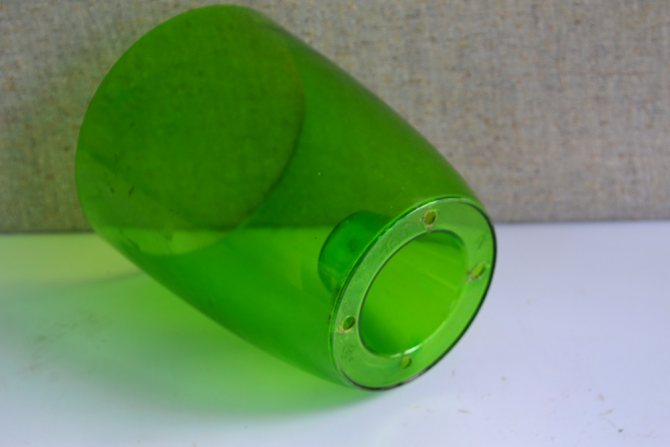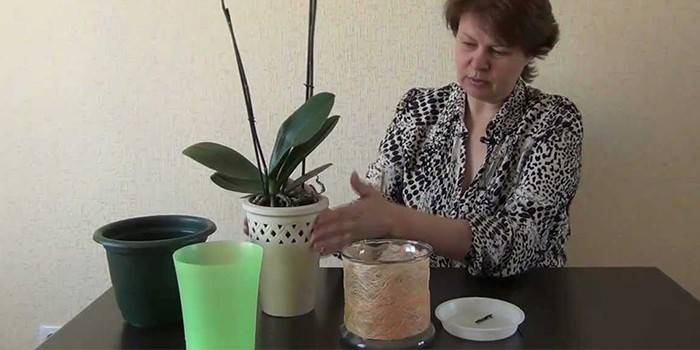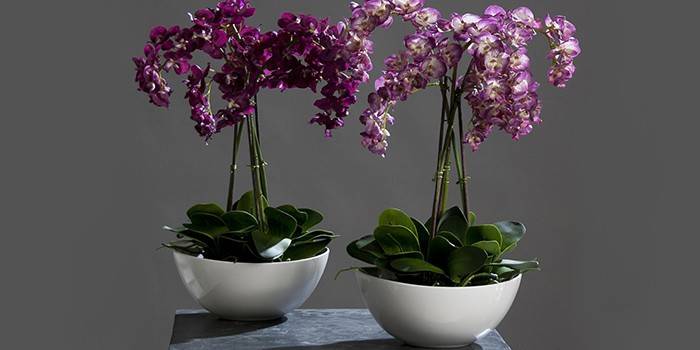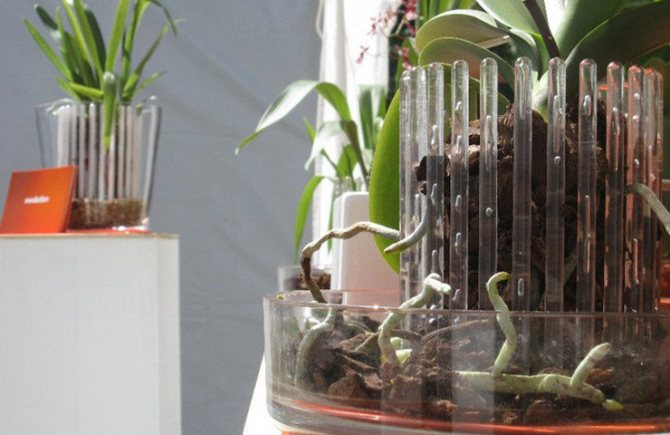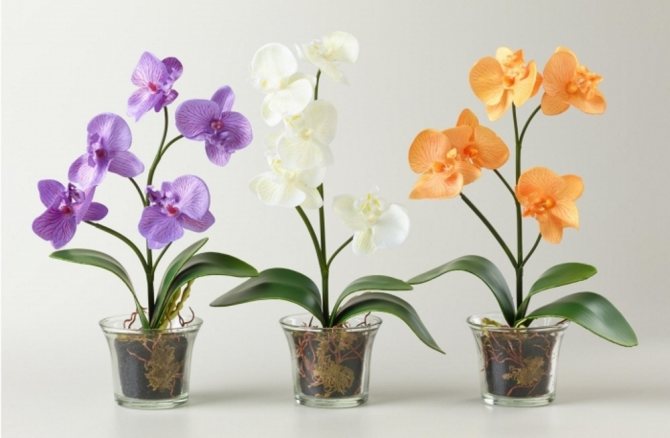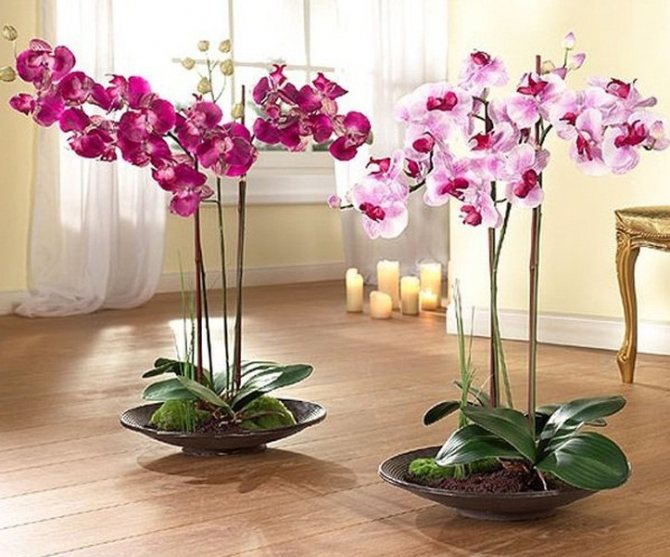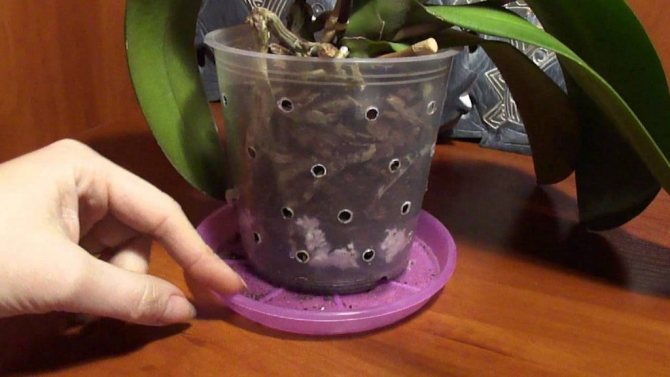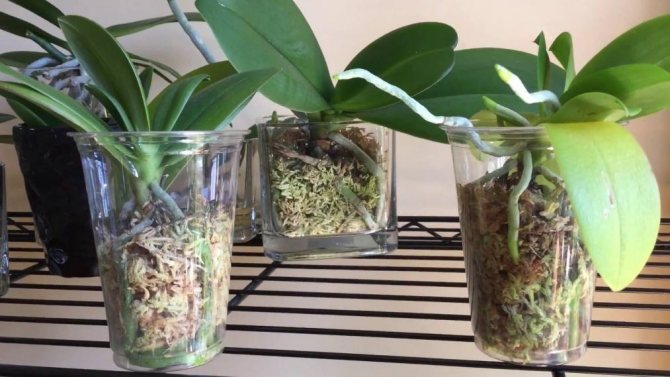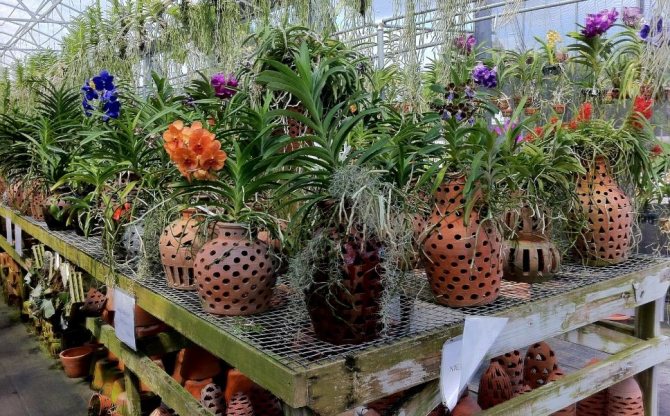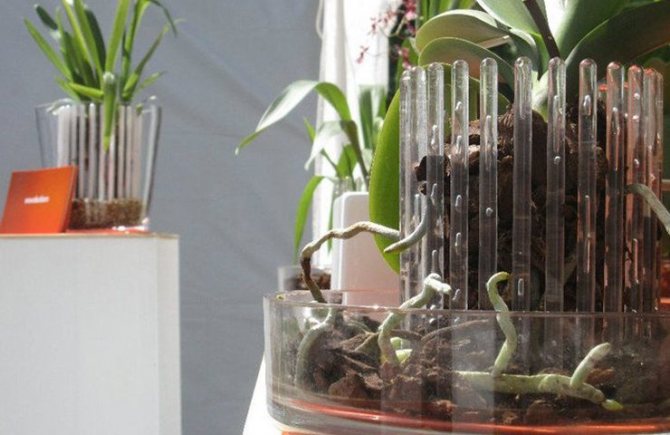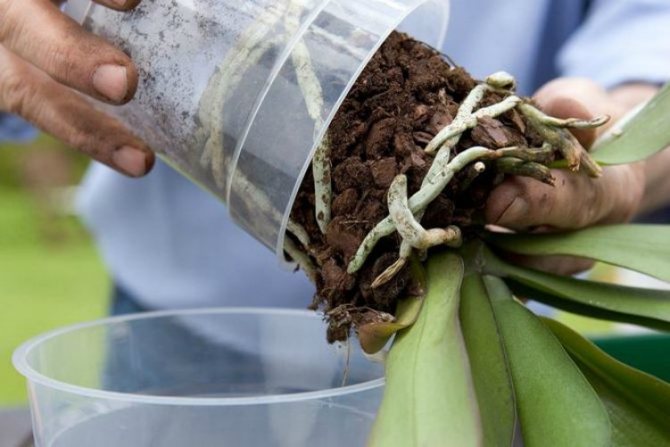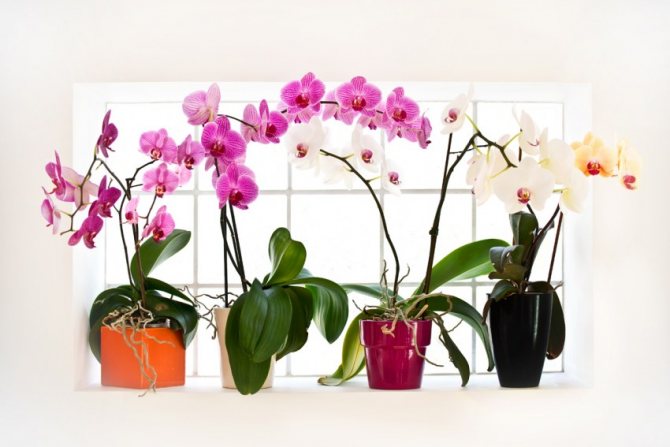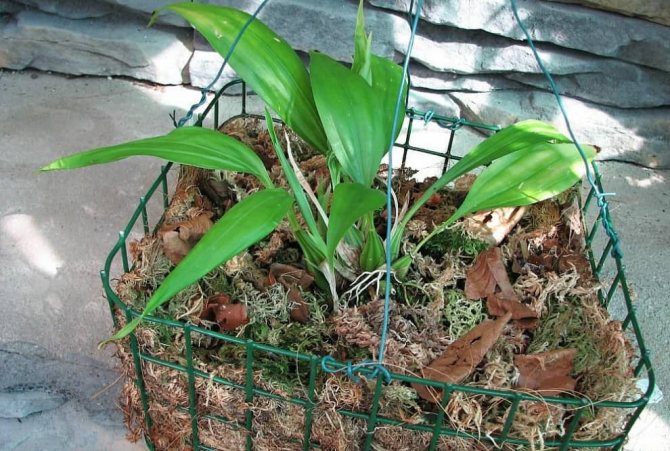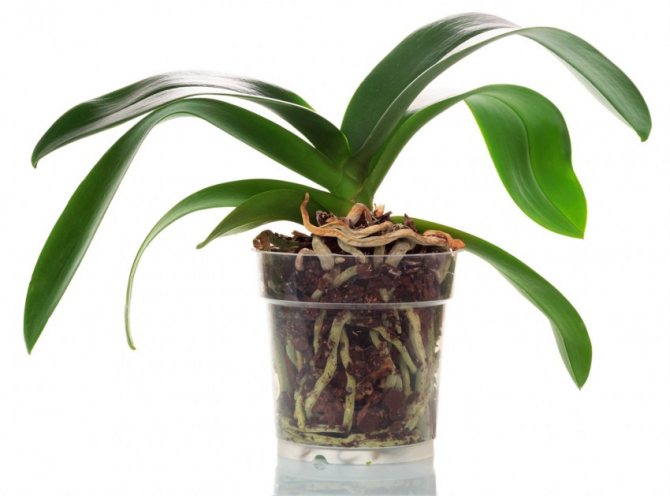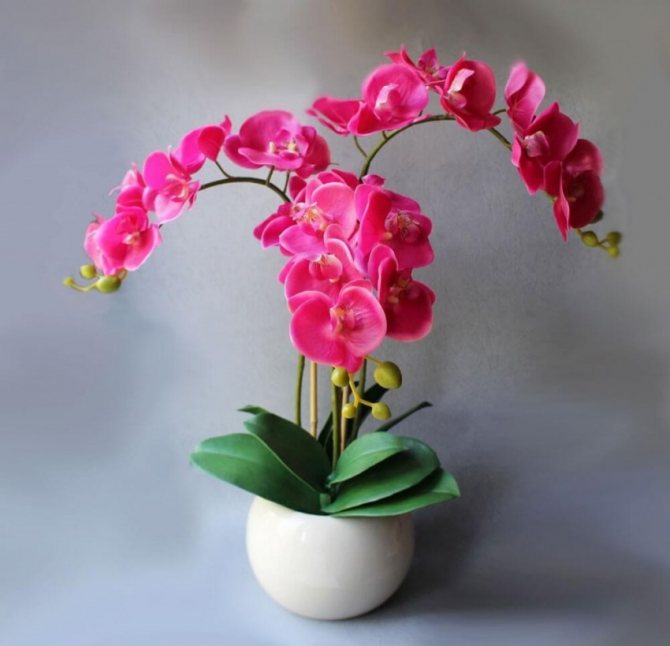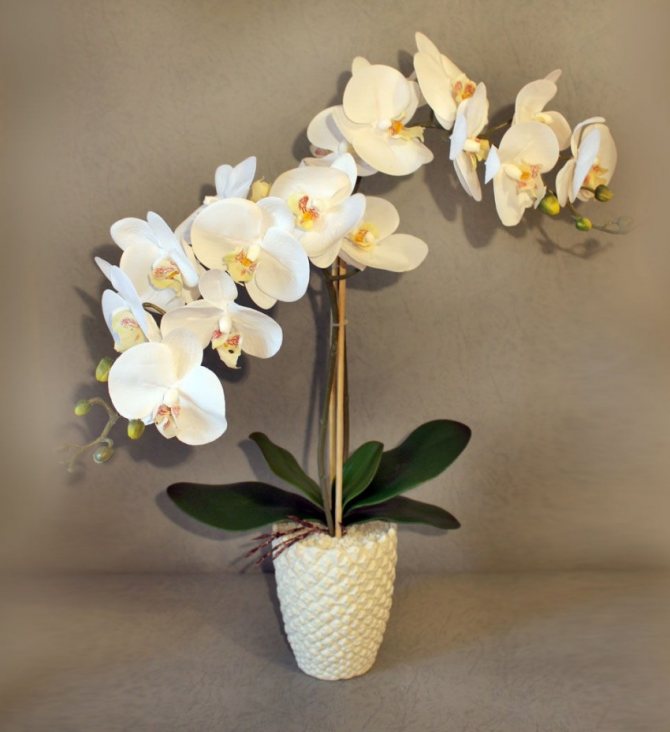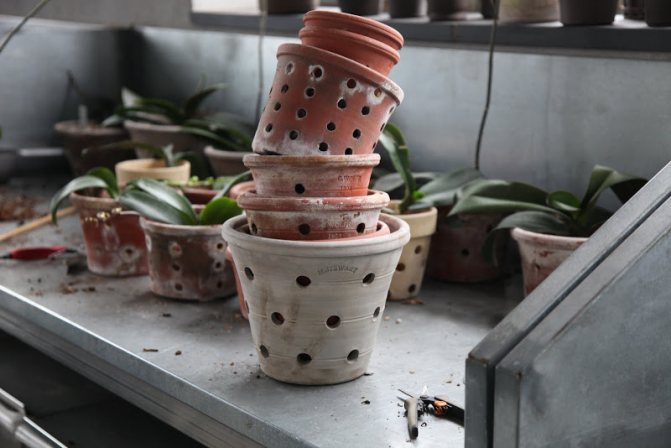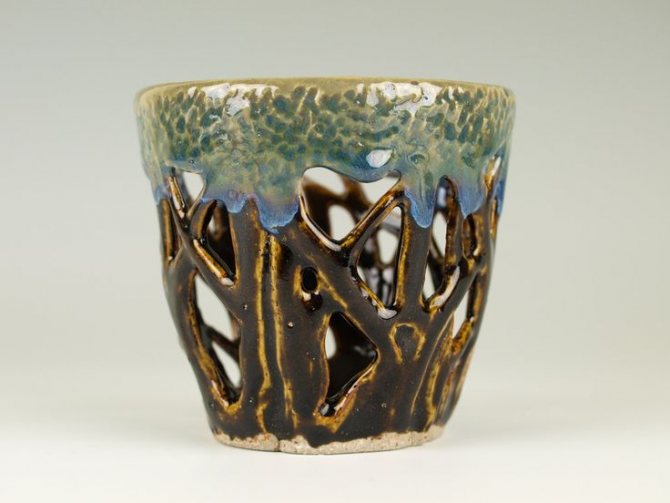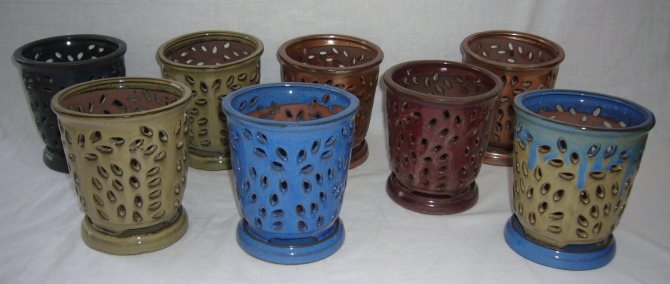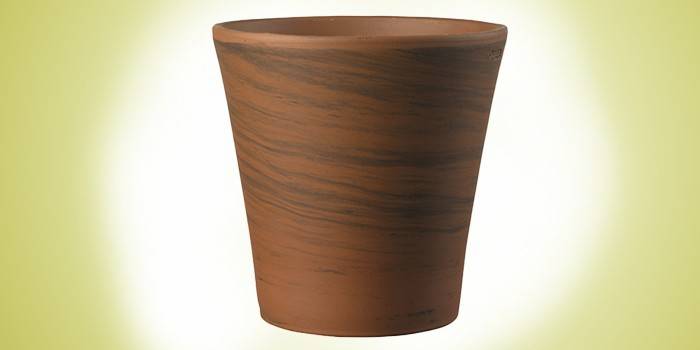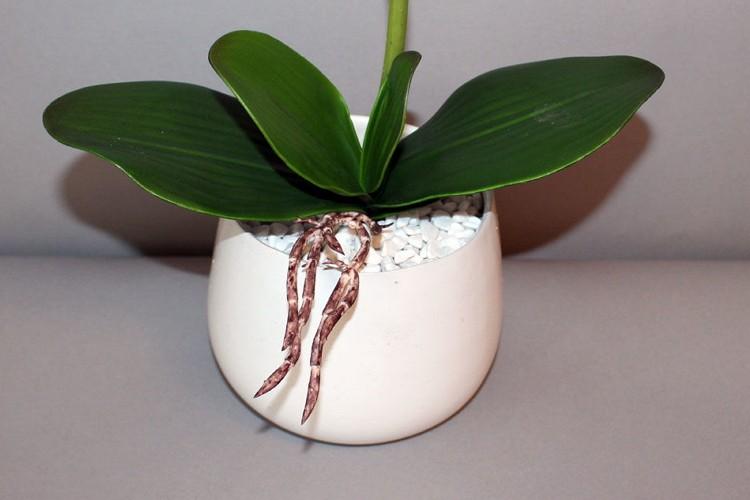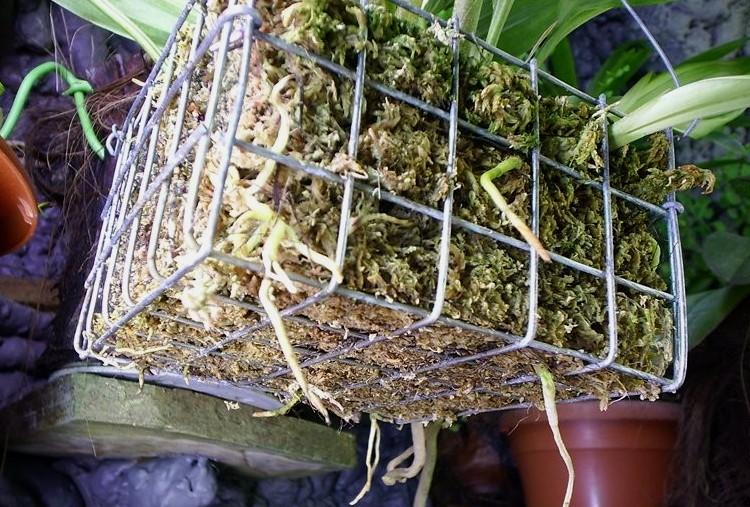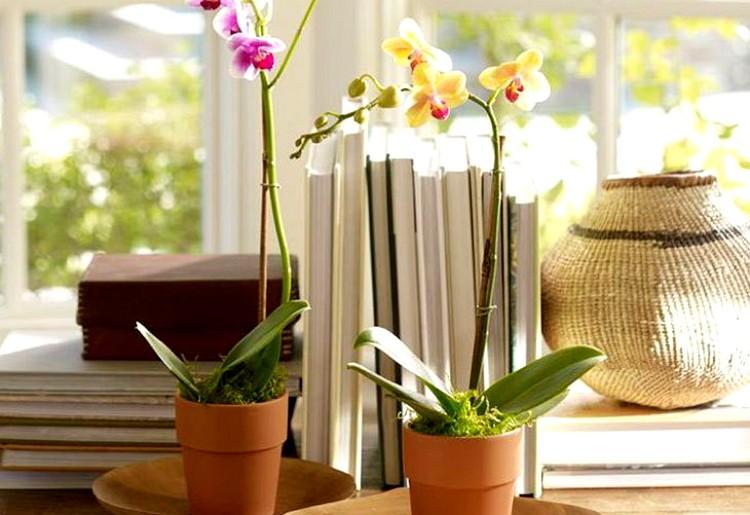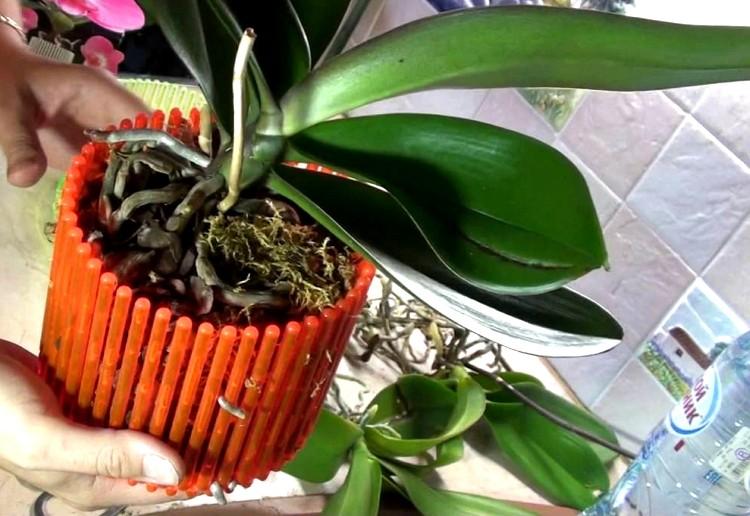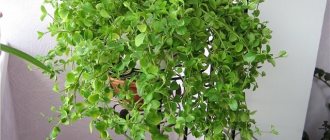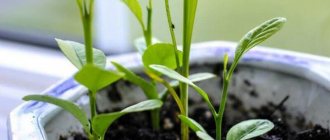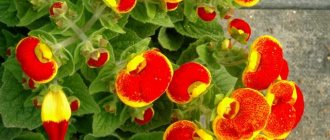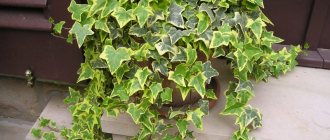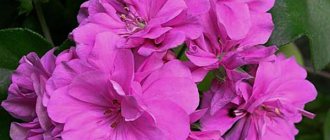When choosing a flower pot, first of all, we pay attention to our own tastes and the available budget. However, with regard to the orchid, not everything is so simple. This is a rather capricious plant that requires a special attitude towards itself. Our experts have figured out how to choose an orchid pot and which products are most popular with flower growers.
Phalaenopsis needs
Orchid and phalaenopsis have the same needs: light, air, moisture, nutrients. These factors are the same for them, since the word orchid is the name of the flower family, phalaenopsis is the name of a genus of plants in the orchid family. Phalaenopsis orchid has gained popularity among flower growers with touching grace and beauty.
The first glance at the plant has a simple structure, however, a more careful study of it strikes with strict simplicity and logic. Each element of the plant has its own function. The main thing for these plants is light, moisture, air.
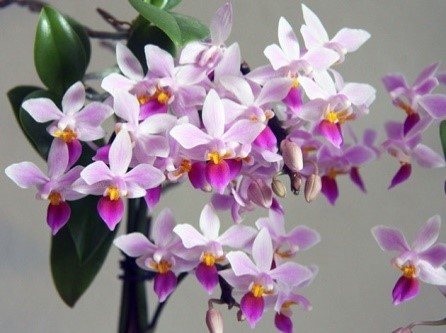
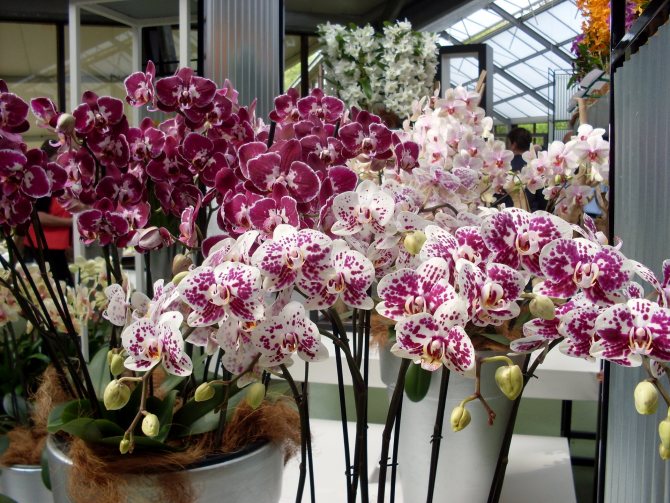

The refined, unique beauty of orchids attracts many flower growers. It is better to grow them in greenhouses. However, thanks to the work of breeders, it is now possible to purchase various species and varieties that grow successfully in a room. The lighting and temperature of the room are perfectly acceptable for them. However, an important question arises: in which vessel to plant the plant?
For your information. Phalaenopsia roots increase the photosynthetic process when they receive additional lighting. Therefore, it should be placed in a transparent pot, this will make it possible to control the condition of the plant.
Phalaenopsis blooming in greenhouses and apartments are hybrids, descendants of the genus Phalaenopsis, the birthplace of which is the tropical rainforests of the regions of Southeast Asia. As a result of breeding, orchids changed the color scheme, size and shape of flowers, but retained their basic natural habits:
- love for a constant warm temperature in the range of 20-28 ° C;
- habitat on tree trunks growing above streams, wetlands of the forest. The aerial roots of orchids rise to the top of the tree, wrapping around it with their strong, tenacious roots;
- The plants get the water they need from the same roots that absorb it during the rainy season, the damp morning fog, and the moisture-saturated ambient air.
- The nutrient composition, consisting of washes of decay products from foliage, bird droppings, insects, is also absorbed by the roots and used by the plant.
For orchids, tree trunks serve as a support on the path to light and sun, they do not take anything away from the plant. Based on these needs of the phalaenopsis, approximately the same conditions should be created on the windowsill.
The main requirements that must be met by lovers of growing orchids are:
- clean air with the necessary humidity,
- no dust,
- correctly selected vessel,
- substrate.
Drinking pots
Drinking bowls (orchid bowls) are often found on sale, which must be handled correctly. They should be used not for planting flowers, but as a planter, inserting a container with a plant inside:
- Model name: Lavender (manufacturer - JetPlast company).
- Price: 98 rubles.
- Characteristics: diameter - 29 cm, height - 23 cm, volume - 2 liters, transparent product.
- Pros: the special shape of the bottom (bottom notch) contributes to the nutrition of the root system.
- Cons: very fragile material.
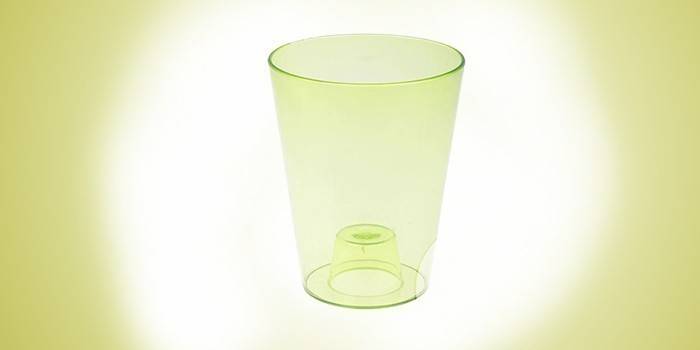

Structures with mechanical irrigation are designed to maintain moisture in the container, saving the soil / substrate from drying out. An orchid in a pot of this type will feel great during the owner's long absences:
- Model name: Matilda (manufacturer - Ukrplastic).
- Price: 258 p. for the action.
- Specifications: 24x22 cm, 5 l.
- Pros: a wide range of colors.
- Cons: very roomy, suitable only for very large plants.


The value of a vessel for growing an orchid
Creating conditions close to the genetic needs of phalaenopsis is the main task when growing them in a room. The absence of roots in phlenopsis determines the specific choice of the vessel. In this case, one cannot be mistaken in choosing a container - a plant planted in an unsuitable container is not able to give the very luxurious flowering for which orchids are bought.
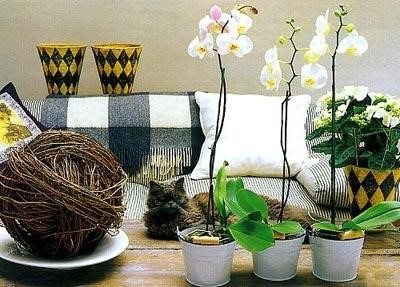

Based on the requirements of the orchid that it needs, we will consider all the options for containers, find out which dishes are most suitable for the hybrid.
After purchasing phalaenopsis, caring for it consists in proper watering and maintaining the temperature regime that is optimal for this plant.
When buying an orchid, you probably noticed that the container in which the seedling is placed is transparent and filled with a substrate that does not look like ordinary earth. This technique provides light access to the roots of the plant and allows you to control the state of the substrate and roots. The plant needs very careful, careful watering. It is advisable to do without water at all, but provide the plant with high humidity.
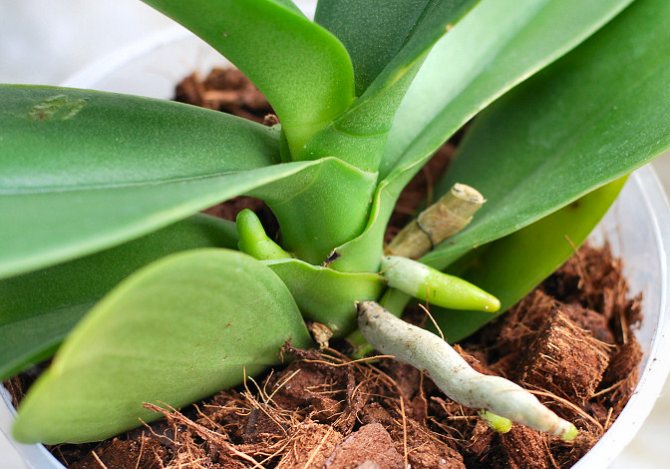

Two years after the purchase of the seedling, agricultural technology changes slightly. The time for top dressing and more volumetric watering begins.
For feeding, use liquid fertilizers marked on the container - "For orchids". Doses should be small. Usually, instructions for dosage and watering are attached to the package.


General concepts
How is a planter different from a regular pot?
- There are several interesting interpretations of the word itself. The origin is French. Cache-pot "-" hidden pot "or" hide pot ":
- A decorative vessel without holes in the lower part. A pot with a plant is installed inside;
- Decorative shell. Optional for pots;
- Vase for disguising a flower pot. "Cover for a flower pot." Redkin's Russian dictionary;
- The difference between a planter and a simple pot is obvious. The pot is placed in a planter. But not a planter in a pot.
What is it for?
It is quite difficult for each plant to provide conditions that resemble the climate from the places of origin in an apartment. So, what should be a planter for orchids:
- It is not necessary to create waterlogging for them. It is even harmful;
- Moisture should go away easily, no problem;
- The substrate and container must provide good aeration;
- It is necessary to extract the root system from them without much difficulty. And the roots are original. They are long and powerful in many species;
- Maintain a certain temperature regime;
- Provide light access to the roots. In some species, the roots are involved in photosynthesis. Give them transparent pots and pots;
- That is why pots, pots, vases, blocks and baskets.
Orchid transplant
A grown, matured plant that has undergone adaptation to a new environment needs to be transplanted to a permanent habitat. TOWhich one is better to choose a pea for an orchid? It should be perfect not only externally. The orchid must find a home that will allow it to grow, gain strength for flowering.
For your information. When transplanting an orchid, wounds remain in place of the removed roots, so watering is allowed only after 2-3 days. During this time, the wounds will heal a little. The watering mode will also change. You should more closely monitor the fresh substrate, as it dries faster than the old one.
Since the orchid does not need an annual transplant, the choice of an ideal pot for it has to be chosen. On sale are pots made of various materials. Let's consider all of them.
Bad options
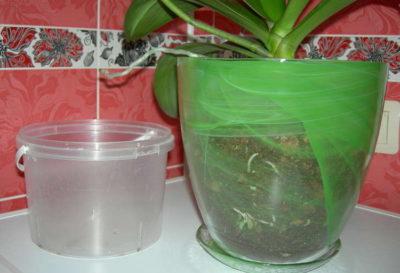

For growing orchids, glass containers are not the best option. The reason is that the holes cannot be drilled, therefore, the ventilation of the root system will be insufficient.
The flower will feel even worse in a ceramic container.... K will begin to grow to the walls, therefore, there is a high risk of injury during transplantation.
If the container for the orchid was selected incorrectly, then this is fraught with the following problems:
- decay of roots - if you choose a pot without holes, then the water will start to stagnate, which is fraught with decay;
- lack of flowering - this is the result of an incorrectly selected pot size;
- wilting and yellowing of leaves - This is a common problem with improperly selected pot material.
Transparent plastic pot
Orchid owners do not think in which pot to grow this flower, as a rule, they prefer transparent and translucent plastic containers. And this is absolutely correct. Especially if such a vessel has holes.
Thanks to the use of such vessels, orchids get:
- good lighting of the root system;
- perfect drainage of water through openings in the bottom of the vessel;
- ventilation of the roots;
- the material has a stable temperature by its structure. Plastic is not subject to overheating and hypothermia, which protects the orchid from sudden changes in temperature.
Wooden, bamboo, plastic and metal baskets
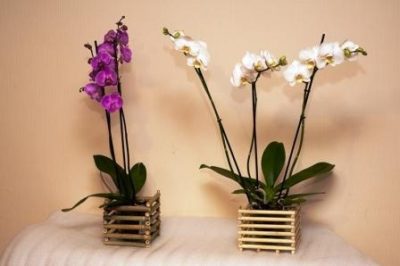

Wooden products are quite decorative and easy to manufacture, but at the same time, the root system of the orchid strongly adheres to the wood, which causes inconvenience during transplantation.
Therefore, often, in order not to damage the plant, they simply make the same container of a larger size and place a basket with an orchid there, and the resulting space is covered with a prepared substrate. Bamboo baskets have a smooth structure and do not pose this problem.
To make pots, you need to prepare wood strips or bamboo sticks, corresponding to the size of the future container. Next, small holes need to be drilled on both sides. The material is laid at an angle of ninety degrees, observing the coincidence of the holes.
The connection of the strips and sticks is carried out with the help of copper wire, which is twisted from the bottom of the product into a strong knot, and its upper ends are tied into rings so that the basket can be easily suspended, for example, on a fishing line that can withstand a lot of weight and is almost invisible. If desired, it can be wrapped using decorative rope or other material.
Baskets made of plastic or metal mesh are more durable, but often require additional decoration.
In order to prevent the substrate from spilling out when planting orchids in such baskets, you need to close the gaps obtained during the manufacture with sphagnum moss, and place a large bark on top of it to the entire height of the product. After that, you need to fill the pot with a substrate, place a plant in it, and then cover the entire surface of the soil with moss to slow down its drying.
To finally find out which pots are suitable for orchids, let us also recall such a wonderful and useful thing as automatic watering of plants. In the video you will see what baskets, pots for orchids are:
Clay and ceramic pots
Clay and ceramic containers have a number of advantages of natural materials. The porosity of the clay provides the vessels in which the orchid should grow, high air permeability, which is necessary for its roots.Due to another property of kaolin, water impermeability, moisture is evenly distributed throughout the entire volume of the pot, which protects the roots of the plant from drying out.


However, some of the advantages of the material turn into disadvantages due to the qualities of the orchid, which has retained its epiphytic ability to stick to the surface for lifting. Under the conditions of the vessel, they are firmly held on its walls and, if a plant needs to be transplanted, there is a danger of damage to the plant roots.
Most likely, an orchid in a vessel made of clay or ceramics will hurt, because with irrigation water and top dressing, the inner surface of the pot will be covered with salts. Consequence: a decrease in porosity, aeration of the vessel, the death of the plant is likely. Such a vessel is not suitable for orchids.
But! Manufacturers don't sleep. They produce very beautiful ceramic pots with special holes. They can be coated with glaze. Such containers are even very suitable for growing phalaenopsis, moreover, they eliminate the need to hide unattractive plastic with decorative pots.
Lechuza system with automatic watering
The modern market for such products offers another convenient and decorative option for planting any kind of orchid - lechuza.
The set of such planting pots includes several components:
- pots lechuza;
- separator;
- lechuza-pon soil;
- automatic irrigation system.
Operating principle
The separator, installed in the pots, is filled with a substrate, then the plant is planted. The first two weeks it needs to be watered superficially until it takes root. Then water is poured into the tank to the full mark. Further, the automatic irrigation system itself will take care of the plant's moisture needs.
According to the device, such containers are different: some provide for bottom watering of the plant through the roots, others - seepage of moisture on the sides of the substrate. Some systems are additionally equipped with a special drainage, which ensures a uniform supply of water - expanded clay or polystyrene.
A double pot with water tanks, from which the plant absorbs moisture, provides effective and balanced soil moisture. In this case, the risk of drying out and waterlogging is excluded. Therefore, in your absence, the plant will not suffer from drought or overflow, and will retain its healthy and decorative appearance.
Glass container for orchids
Of course, in a glass pot, the roots of the orchid are clearly visible. But it is difficult to grow it in such a vessel. In such a pot, no additional holes can be added to improve aeration and drainage of excess water.
The substrate for growing orchids in a glass container must be prepared with a special approach. It can be properly prepared by growers with extensive experience in growing phalaenopsis. Only they will be able to find the right drainage layer. Such nuances will provide the orchids with the necessary air exchange. Otherwise, algae will grow in the glass, due to the improper drying mode of the substrate, the roots will rot, which will cause orchid disease. With strict adherence to all the rules, you can allow the cultivation of an orchid in a glass vessel.
How should a plant be planted?
Per block
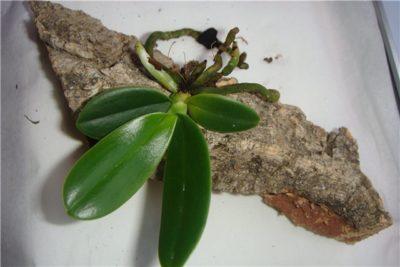

To grow an orchid in conditions as close as possible to its natural, it is worth choosing the option of planting on a block. A block is a piece of bark that is sized to fit the plant's root system. While the flower is small, you can use foam instead of bark.
You can grow an orchid on a block with and without a substrate... If the latter option is chosen, then the orchid is grown on a suspended wire or on a fishing line. A tree variety that does not rot (mango tree) is suitable for growing. You can find it in pet stores and in the departments with accessories for aquariums. How to make a block for an orchid with your own hands, as well as the rules for growing a flower, read here.
Growing an orchid on a block allows you to water the plant less often, since the moisture will not go away so slowly, I stay in the substrate.
Sphagnum moss, which grows in swamps, is perfect as a substrate.... The disadvantage of this method is that the root ball will dry out quickly - in the summer, a few hours are enough. So it is worth using block planting for orchids grown in a greenhouse.
Watch a video about planting an orchid on a block:
In garbage
A basket is the best option for those who want to recreate the natural conditions for an orchid, but do not want to plant it on a block. Various materials can be used to make the basket:
- bamboo;
- wood;
- steel;
- plastic;
- metal mesh.
TIP: The basket made of bamboo and wood looks quite original. But the wooden structure has one drawback: the root system grows strongly to it, which is traumatic during transplantation.
Bamboo is most beneficial... To make a basket you need:
- lay out the planks or a piece of bamboo;
- make a hole in them and stretch the fishing line;
- all that remains is to hang a homemade basket and plant a plant in it.
Plastic baskets remain quite practical, but less decorative.
A pot of scrap material
It is not difficult to make a suitable container with your own hands. Having chosen the material for the pot, having decided on the size, you can start creating a future abode for the orchid. The most affordable material - any plastic containers, you do not have to limit yourself in shape and color. Although, of course, it is better to take transparent containers from mayonnaise, yogurt, sauces, etc.
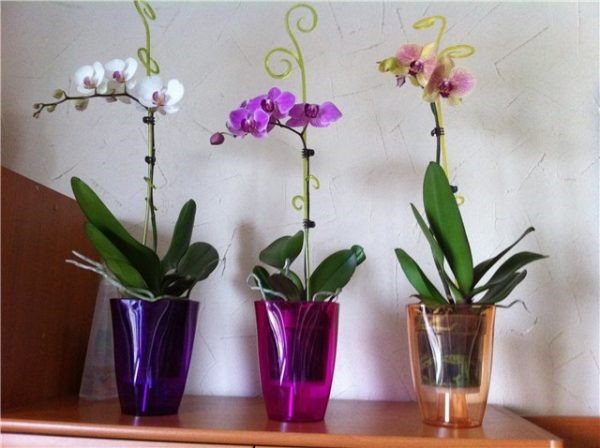

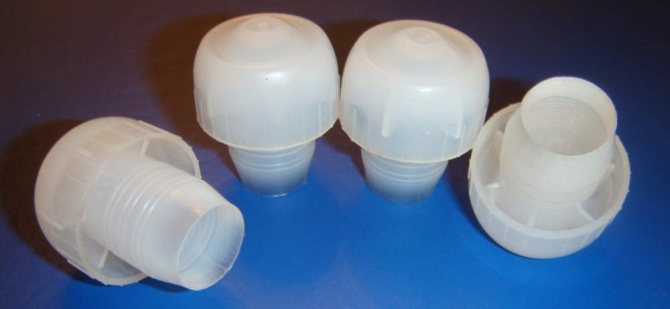

Using a screwdriver, drill or any suitable tool, many holes are made in the bottom of the container container. Holes are also made in the side walls.
To prevent the flower roots from spreading tightly along the bottom, a plastic champagne cork should be placed in the middle of the bottom of the vessel. This technique will improve air exchange in the vessel.


Special purchased plastic containers for orchids.
Another option for a homemade pot is natural materials that mimic the conditions native to the plant:
- Coconut.
- Bars of wood.
- Pieces of bark.
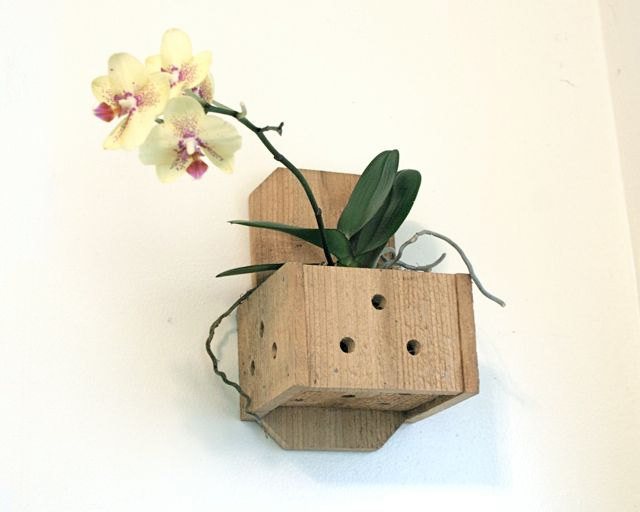

From glass
Glass pots for orchids are used as decoration. Plants in plastic pots are placed in them. You can choose a glass orchid pot to your liking, the main thing is that it is 2-3 cm larger in diameter than the plastic container.
The main advantage of glass pots is the ability to monitor the state of the root system and regulate its watering. Water is poured from a watering can along the edge of a plastic container. The liquid flows down to the bottom and seeps through the holes, sinking to the very bottom. The plant saturates the required amount of moisture and distributes it evenly throughout the root system.
It should be understood that such a phalaenopsis orchid pot cannot be used for planting, since it is made with a cast bottom - without drainage holes.
Therefore, if you have a question, which is the best ceramic or glass pot for an orchid when planting or transplanting, give preference to the first option.
Today, glass pots of different colors, shapes and sizes are on sale. Most often they are used to grow Fijian orchids, phalaenopsis and other small plants.
Orchid pot and its dimensions
An important nuance in the cultivation of phalaenopsis is pot size... Observations show that the orchid feels most comfortable in a pot, somewhat cramped for it, this is a natural feature of the plant. Therefore, the characteristics of the pot in which it is better to plant phalaenopsis should be as follows:
- the height and diameter of the pot should be equal to the diameter of its neck;
- the root system of the orchid should completely fill the volume of the vessel;
For transplanting an orchid, you should choose a vessel slightly larger than the previous one in volume. This is a necessary condition for the unique plant to retain the ability to maintain health and strength.
What to consider when choosing
Orchid is an epiphytic plant, it does not tolerate waterlogging of the soil poorly. When choosing a landing container, this should be taken into account.
Orchid pots must have the following properties:
- active aeration of the root system and substrate;
- good moisture drainage;
- safe and easy extraction of the massive root system of the plant, which often goes beyond the container through the drainage holes;
- the ability to maintain the required temperature for the underground part of the flower.
Size Requirements
A pot of the appropriate size is selected for the orchid. Given the natural feature of the flower, it requires a slightly cramped flowerpot. In such conditions, the flower will bloom faster than in a voluminous flowerpot.
Parameters of a pot suitable for an orchid:
- diameter and height should correspond to the size of the neck;
- when choosing a container for a flower, take into account that its root system fits completely in it;
- when transplanting a flower, choose a flowerpot by volume 1 cm in diameter larger than the previous one.
Orchid substrate
At home, a slightly unusual soil is needed for the phalaenopsis orchid, Its basis is the bark of a pine tree, which is processed in a certain way:
- cut the bark collected in the forest into small pieces, boil and dry. This is necessary in order to avoid the development of pathogenic fungi and mold;
- cooked pine bark is mixed with expanded clay and charcoal. The ratio of the components is 2: 1: 1.
In such a mixture, coal and expanded clay will act as moisture accumulators, then saturate the bark with it. Charcoal will serve its purpose as an antiseptic.
The orchid needs to grow in the right substrate, whether it is homemade or store-bought.
For your information. Phalaenopsis is very sensitive to moisture. Lack of moisture in the plant will cause it to wilt, with an excess of water, the root shell is disturbed and the plant dies.
Photo
Next, you can see the photo of what pots are needed for orchids:
Phalaenopsis place in the room
Having determined the material of the pot, what size the vessel for the orchid should be, having prepared the substrate, you need to choose a place for the flower in the room.


Phalaenopsis feels good on the east-facing window. A window facing south or west is recommended to be protected from bright light with a curtain. You can determine the lack or excess of light by the color of the foliage. It should be olive green.
After flowering, the phalaenopsis is pruned and set to rest in any place away from bright sunlight.
What is the best way to grow?
An orchid needs a lot of soil, so a small pot will not work. (about the ideal substrate for orchids - seramis, as well as about the features of growing flowers in it, read our article). When buying a pot, you must adhere to the following recommendations:
- there should be drainage holes at the bottom of the tank and its lower part of the walls;
- the height of the container should be equal to the width of the neck;
- the volume of the container should correspond to the size of the root system.
What are the criteria for choosing a pot for an orchid?
The successful development of the orchid depends on the quality of the pots. When choosing it, several important parameters are taken into account: shape, size, material and functional properties. Moreover, the container must ensure the safety and constant aeration of the roots.
Moisture outflow
For the passage of water through the soil and the correct removal of excess in the pot, it is necessary not only in the bottom, but also along the walls at a distance of about 1 cm from the bottom. With proper outflow of water, the risk of root rot in liana is reduced.
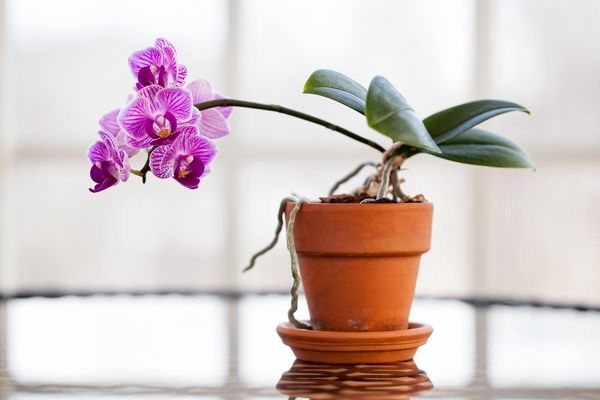

Root aeration
The roots of the tropical beauty are enveloped by a specific spongy dead formation filled with air. If there is no air circulation in the root zone, this tissue rots and dies. The roots are left unprotected, and the vine dies.
Aeration of the roots is ensured by their correct location: on your finger from the sides of the pot. So the air will circulate freely, and the drying of the soil will be timely.
Advice! The fan, just not very large, will artificially improve air circulation.
Root system security
A cramped orchid house is a negative factor. The risk that the roots will be damaged during transplantation increases. Inexperienced amateurs think that if the roots have crawled out of the pot, this is a sign: it's time to replant the vine. They forget that they have an epiphyte in front of them, and aerial root system is normal for him.
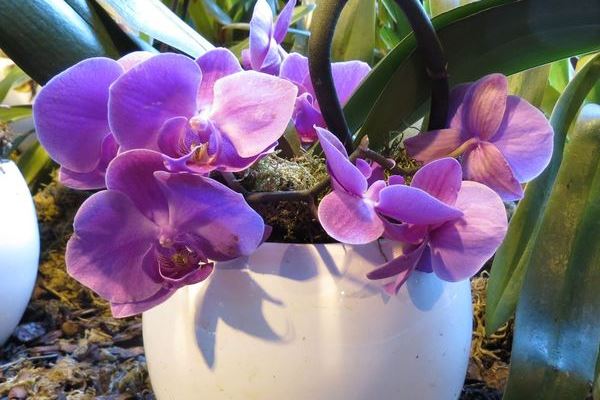

To remove the roots without injuring them, the diameter of the pot should only exceed the volume of the roots by 3-4 cm.
Do-it-yourself planter for a plant
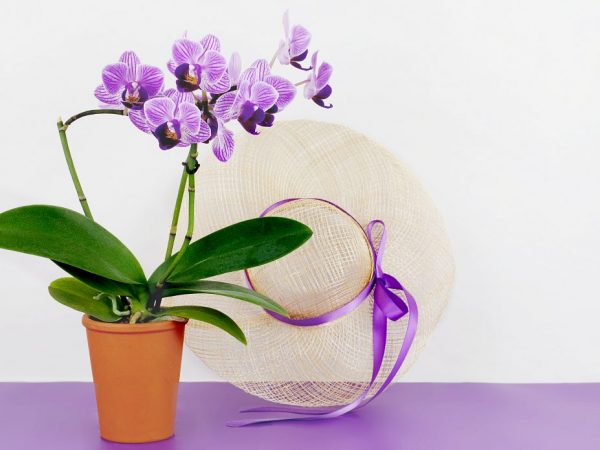

The pot can be either purchased or homemade
Anyone can create a beautiful and practical vessel for indoor plants with their own hands. If it is made from plywood or blocks, you should make several pieces of the same size and fasten with a hot gun or glue, and then smooth the edges with sandpaper to make them smooth. It is worth covering the plywood with oil or acrylic paint.
The container is made with your own hands from the remaining ceramic tiles and concrete, using the popular mosaic technique, so that it does not look boring. Pipes, burlap are also used, and large shells, stumps, wicker vines, and coconut shells are popular among natural materials. If this does not seem original enough, then you should think about using old unnecessary things. A suitcase, tin cans, used floppy disks and records, hats, plastic bottles, car tires and even pieces of furniture are suitable for this.
Errors and fixes
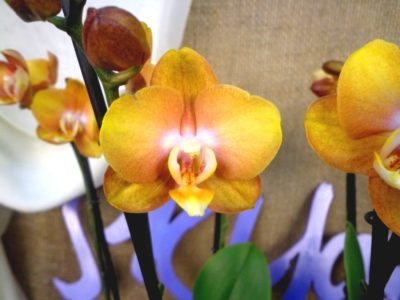

Phalaenopsis is a plant that reacts very badly to transplantation, therefore, it should be transplanted only in extreme cases:
- Moisture stagnates in the pot - this can lead to decay of the horse system.
- Poor air exchange - can lead to the death of the plant, but if the phalaenopsis looks healthy, then the transplant is not necessary, the main thing is not to overfill the orchid.
- A small pot is not a problem for phalaenopsis. If the plant tilts under the weight of the peduncle, you can put the pot in a planter and transplant only after the end of flowering.
- Too large a pot requires immediate replanting to avoid root rot.
Choosing the right pot and the right growing conditions will bring the desired results, in the form of a spectacular flower. If you follow all the rules for caring for phalaenopsis, then a healthy and beautiful plant will definitely grow.
The conditions for keeping flowers in stores and at home after purchase are significantly different. We recommend that you look at our articles on the rules for home care after purchasing phalinopsis, as well as how to feed the plant and how to separate the baby from the peduncle, stem and root.
The optimal solution for the plant
The most optimal solution for growing an orchid would be to purchase a transparent plastic pot with holes on the sides. Such a flowerpot is able to provide good moisture permeability and air access to the root system of the flower.
In addition, in such a container, the roots have the opportunity to fully develop and do not grow to its walls. Another plus in favor of a plastic pot is its budgetary cost compared to options made of clay, glass or bamboo.
Suitable sizes
Having figured out why orchids are planted in transparent pots, you should pay attention to the number of cubic centimeters that can fit into the container.The growing phalaenopsis stem is designed in such a way that it does not need large pots for proper growth. To choose the right model for transplantation, you should rely on a few simple rules:
- It is enough to look at the growing system. The volume of the new container must contain it completely. When transplanting, the phalaenopsis pot is determined by the diameter of the past with the addition of 1-2 cm.
- The height must be identical to the diameter. It is these proportions that will allow this system to develop correctly.
- An object with a narrowed top is prohibited. The formed power supply system cannot be transported.
Important! When planting two plants in one container, it is important to summarize the needs of both, and based on this, choose the required volume.
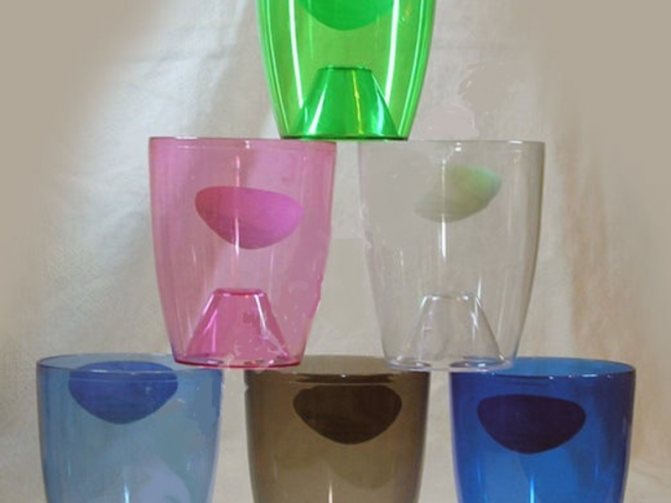

Where to buy and how much will it cost?
There are two options for purchasing an orchid pot: online or at a specialized flower shop. The cost of pots varies from 50 to 2500 rubles, depending on the material from which it is made.
Choosing the right pot for your orchid is a responsible process, but it is not as difficult as it might seem. The main thing is to have a good idea of what it should be and be guided by such criteria as material, size, aeration, moisture permeability and design.
What is required to create
For the manufacture of such containers for orchids, wooden strips (blocks) or bamboo sticks are used. This will require the following tools and materials:
- Slats with a section of 1x1 or 1.5x1.5 cm. It is advisable to choose wood that is more resistant to decay: beech, oak. Or it can be bamboo sticks with a diameter of 1.5-2 cm.
- Abrasive paper, grain size 80-120.
- Soft copper wire with a cross section of 2-3 mm. It is not worth taking aluminum, it will quickly break.
- Chain, cord or string for hanging.
- Antiseptic for processing wooden blocks.
- Napkins.
- Round nose pliers or pliers.
- Hacksaw for wood
- Vise
- Drill and drill bit 2-2.5 mm.
- Wood screws
- Screwdriver
Useful Tips
When choosing a planter, you need to follow a number of simple tips:
- You should not plant an orchid directly in heavy ceramic pots, this is harmful to the plant.
- The inner pot should have an optimal number of drainage holes, but water should not just pour out of them, but stay in the soil.
- There should be a layer of air between the planter and the main pot.
It is easier for beginners to use plastic pots with transparent walls, so that it is convenient to observe the condition of the plant roots. Moreover, less salt is deposited on plastic walls than on clay ones.
We also suggest that you find out what to do if the orchid has stopped blooming.
Facilitation of care due to additional options
Over the years of cultivating orchids at home, many devices have been invented that greatly facilitate the care and maintenance of a tropical beauty.


Autowatering
Flower shops sell pots equipped with automatic irrigation. Many growers make such a device on their own from plastic containers. The automatic watering option allows you to accurately calculate the amount of moisture. In addition, it is relevant during periods when the owner needs to leave home for a while.
Other fixtures
Another useful option that allows you to set the optimal lighting mode is phytolamp. Blue light, which provides photosynthesis in the leaves of the flower, is turned on during the day. Red lamps are used for the night. The main thing is that the lamp does not emit heat.
Difference from pots
The pot differs from the planter only by the presence of holes in the bottom.... You can plant an orchid in any of these containers, but it is better to remember that the care and control of the plant will be different: when growing a flower in a pot, it is possible to provide it with both top and bottom watering, and watering in a pots is done exclusively from above. More effort will be needed to control the water level in the planter.
The consequences of a wrong choice
Carelessly choosing, the florist runs the risk of facing a serious problem. His beauty will rot the roots, as a result of which algae will appear on the walls of the vessel or snails will start. If he doesn't take action, she will die.
What to plant an orchid in? The choice of containers is quite large. On our website you can find information about whether to plant in a transparent pot or not, about the "crown" pot, about planting in a glass vase, as well as about blocks for orchids.




